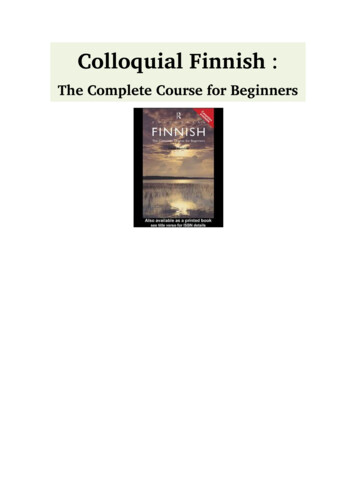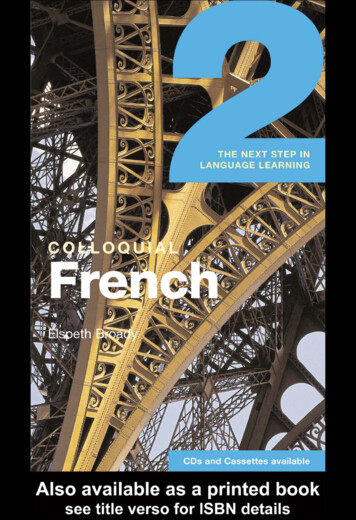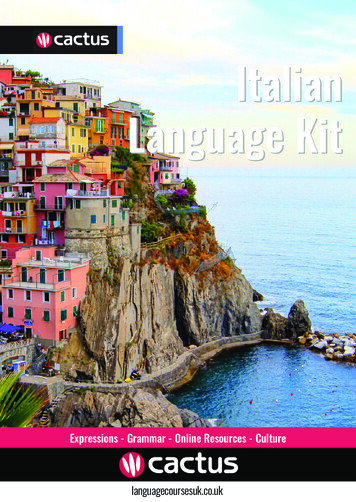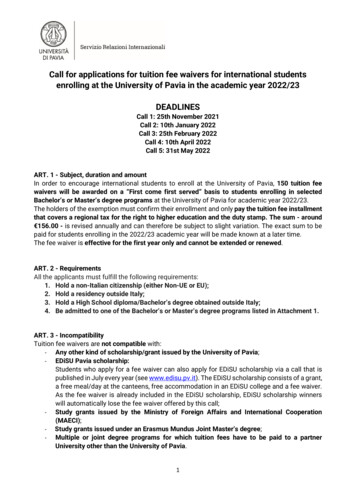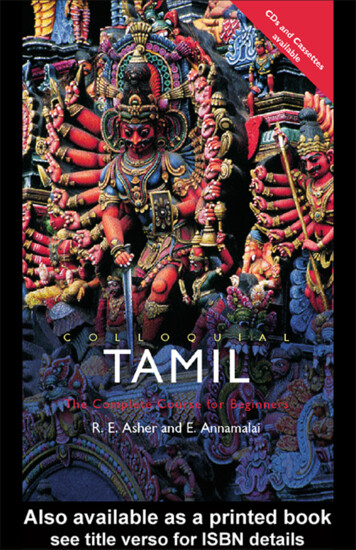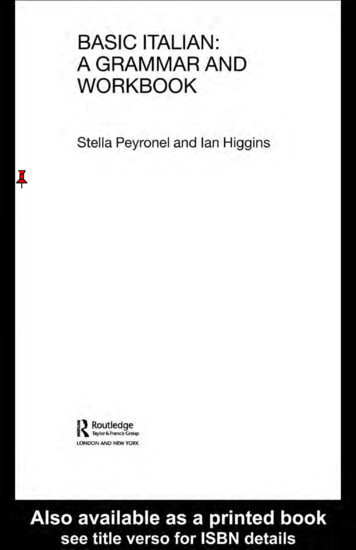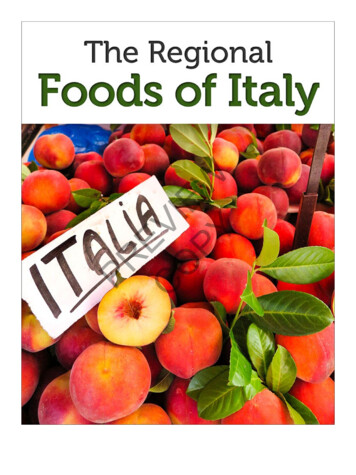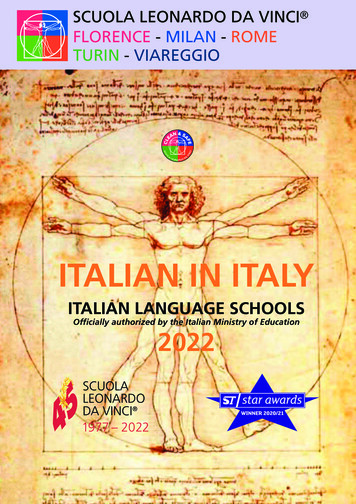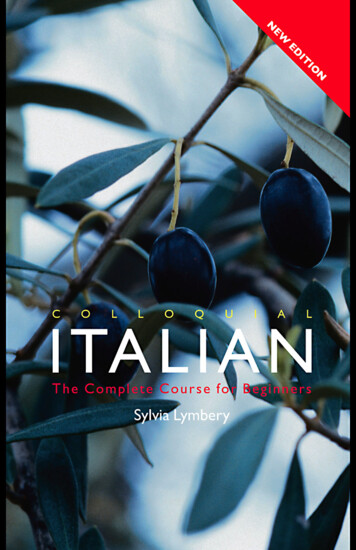
Transcription
ColloquialItalian
The Colloquial SeriesSeries Adviser: Gary KingThe following languages are available in the Colloquial series:AfrikaansAlbanianAmharic*Arabic (Levantine)Arabic of Egypt*Arabic of the Gulfand Saudi lishPortuguesePortuguese ofBrazilRomanianRussianScottish GaelicSerbianSlovakSlovene*SomaliSpanishSpanish of n*UrduVietnameseWelshCOLLOQUIAL CD-ROMsMultimedia Language CoursesChineseSpanishFrenchPortugueseAccompanying cassette(s) and CDs are available for all the abovetitles (cassettes only for the titles marked with *). They can beordered through your bookseller, or send payment with order toRoutledge Ltd, ITPS, Cheriton House, North Way, Andover, HantsSP10 5BE, or to Routledge Inc, 270 Madison Ave, New York, NY10016, USA.COLLOQUIAL 2s SeriesThe Next Step in Language LearningDutchRussianFrenchSpanishItalianSpanish of LatinAmerica
ColloquialItalianThe Complete Coursefor BeginnersSylvia Lymbery
First published 1996 by RoutledgeReprinted 1998, 1999 (twice), 2000, 2001Second edition published 2005by Routledge2 Park Square, Milton Park, Abingdon Oxon OX14 4RNSimultaneously published in the USA and Canadaby Routledge270 Madison Ave, New York, NY 10016Routledge is an imprint of the Taylor & Francis Group 2005 Sylvia LymberyTypeset in Times byFlorence Production Ltd, Stoodleigh, DevonPrinted and bound in Great Britain byTJ International Ltd, Padstow, CornwallAll rights reserved. No part of this book may be reprintedor reproduced or utilised in any form or by any electronic,mechanical, or other means, now known or hereafter invented,including photocopying and recording, or in any informationstorage or retrieval system, without permission in writingfrom the publishers.British Library Cataloguing in Publication DataA catalogue record for this book is available from theBritish LibraryLibrary of Congress Cataloging in Publication DataLymbery, Sylvia.Colloquial Italian: the complete course for beginners/Sylvia Lymbery. – 2nd edn.p. cm – (The colloquial series)Includes index.1. Italian language – Conversation and phrase books –English. 2. Italian language – Textbooks for foreignspeakers – English. 3. Italian language – Spoken Italian.I. Title. II. SeriesPC1121.L95 2005458.3′421 – 71–7(pbk)(audio cassettes)(audio CDs)(pack)
This book is dedicated toCharlotte
ContentsAcknowledgmentsMap of ItalyAbout this bookThe sounds of Italian1 Buongiorno, un caffè per favoreixxxixv1Good morning, a coffee please2 Mi chiamo Harry, sono americano, e Lei?16My name’s Harry, I’m American, and you?3 In città32In town4 In viaggio50Travelling5 Vorrei comprare/Quanto costa?65I’d like to buy/How much does it cost?6 Appuntamenti81Engagements7 Giriamo102Let’s get out and about8 Un po’ di geografia121A little geography9 Buon appetitoEnjoy your meal136
viiiContents10 Buone vacanze148Have a good holiday11 Che cosa ha visto?163What did you see?12 Ecco la mia casa177This is my home13 La vita è cambiata188Life has changed14 Alla salute!202Here’s to your health!15 Buona fortuna!215Good luck!16 Progetti e previsioni – che sarà, sarà232Plans and predictions – what will be, will be17 Un vestito per un matrimonio246A dress for a weddingGrammar summary260Key to exercises278Italian–English glossary303English–Italian glossary337Index346
AcknowledgmentsI would like to offer my warmest thanks to the many friends whohelped me when I was writing Colloquial Italian. In particular, toAngioletta Viviani, whose hospitality and advice helped me startto prepare this new edition, and to Sandra Silipo for help andadvice. Others too numerous to list have helped in various ways,and their support is very much appreciated. Thanks must also goto Antonio Ravarino for his plan and architectural drawings.I am also grateful to: the Editor of La Stampa, Torino, for permission to reproduce a weather forecast; to La Stampa and LiettaTornabuoni for permission to use parts of her article, Italia 1945–1995 Con gli occhi aperti; the Editor and editorial staff of Vera magazine for permission to reproduce parts of the article Per le vie deiborghi doc from the March 2003 issue; Bernardo Cioni and LorenzoEnriques of Zanichelli Editore for permission to reproduce Dott.Cioni’s email; the Mayor of Apricale for permission to reproducethe photo of Apricale from the town’s website: www.apricale.org;Bologna Turismo – Redazione IAT for permission to reproduce thephotos of the Palazzo del Podestà in Piazza Maggiore and of thefruit and vegetable shop in the Mercato Antico; the IAT of Perugiafor permission to reproduce the photo of the Palazzo dei Prioriand the Fontana Maggiore; the Azienda di Promozione Turistica diRoma for permission to reproduce the photos of the Campidoglioand of the Vittoriano; Suzanne Cousin for the photograph of SantaMaria Novella, Florence; the Servizi Turistico-Ricreativi departmentof the Province of Verona for permission to reproduce the photo ofthe Roman Arena; the Comando Generale dell’Arma dei Carabinieri for permission to reproduce the photo of a carabiniere at work.And finally my thanks go to Sophie Oliver and her helpful teamat Routledge.Permission to use the extract ‘Il mio primo computer: Il pc idealeper un bambino?’ from Anna magazine was sought but no replyreceived.
Trentino-AltoAdigeAostaValle d AostaLombardiaMilanoTrento naAnconaMarchePerugiaUmbriaL riaCatanzaroPalermoSiciliaItaly: regions and regional capitals
About this bookSo you are thinking of learning Italian? Or perhaps you are alreadylearning and want another approach to help you on your way?Read on and you will see why Colloquial Italian could be just whatyou are looking for.Why Italian?Italian is the language of Italy and it is also one of the four official languages of Switzerland. With a population of some 58 millionand an area of 301,323 sq km, Italy is a small country; but for morethan two thousand years its inhabitants have had significant effectson civilization, while the land of Italy has for centuries been asource of pleasure and interest to travellers. Today it continues tooffer the tourist many and varied delights: scenery, artistic treasures, music, good food and wine, snow, sun and sea. The ItalianRepublic is one of the founder members of the European Unionand for businesses Italy offers both opportunities and challenges.There are problems of a political, economic and environmentalnature that may frustrate and annoy the traveller but overall Italyis a very welcoming country and a fascinating subject of study.The language is arguably the easiest European language forEnglish speakers to learn. The pronunciation seems easier thanFrench for English speakers, the grammar less tricky than that ofGerman or Russian. Furthermore, the spelling of the languagereflects the way words are said and the meanings of many of thewords are guessable.Italian has its origins in Latin, the language spoken in AncientRome. For anyone who has studied Latin or one of the Romancelanguages (languages derived closely from Latin such as Spanish,French or Portuguese), it is particularly approachable, for not onlywill many more words be guessable but the structure too will be
xiiAbout this booksimilar to that of the language they know. This is not to say it istrouble free, but you, the learner, can feel optimistic as you startthe task.As a nation-state Italy is young. It was united between 1860 and1870 after centuries of division into a number of smaller states. Atthe time of unification Italian was essentially a written languageused by poets, playwrights and other writers. Only a smallpercentage of the population spoke it. Most communicated in theirlocal dialect. Today universal education, military service, population mobility and television and radio mean that most Italiansspeak and understand Italian although many also continue to speaktheir local dialect.Colloquial ItalianThe aim has been to write a book in which the learner, who maynot have experience of learning foreign languages, is helped withthe difficulties, particularly in the early and potentially confusingstages. At the same time we have tried not to insult the learner’sintelligence. As has been said, many Italian words are guessableand we have deliberately challenged the learner by introducing awide vocabulary, confident that he/she will find it manageable. Wehave tried, too, to entertain and stimulate.As a language learner you need to be aware that different peoplelearn languages in different ways. Try to find the way that worksfor you. There are few people who can sit down with a grammarbook, read the rules, do some exercises and start speaking thelanguage. Many people find it helpful to become familiar withchunks of language, for instance the dialogues and texts inColloquial Italian. Listen to the recordings and try to get to knowthem well; go back over them after a break, too, brushing up yourmemory. Why not listen to the recordings in your car while yousit in a traffic jam? Or while you are doing something that doesnot engage your mind? Gradually you will find you can start toexpress yourself in Italian. You can also try talking to yourself inItalian, again in idle moments. It doesn’t matter that you may notalways get it right. It is the practice in trying to find a way of sayingwhat you want to in Italian that helps.Learning a language takes patience and determination. Youwill have your ups and downs, your moments of frustration but
About this bookmoments of satisfaction too. We recommend you try a ‘little andoften’ routine: work at your Italian regularly but not necessarilyfor long periods of time.Many people find it helpful to back up their learning in everyway available to them: exchanging a few words with a friendlywaiter in an Italian restaurant, or watching Italian films. Treat yourself to an Italian magazine or newspaper occasionally. The biggestaid of all is a trip to Italy. Don’t, however, expect too much fromthe first visit. Much will depend on the extent to which you areable to be with Italians and ‘have a go’. ‘Having a go’ is probablythe key to success. But beware: you will always understand morethan you can say. Make the most of each opportunity and aboveall don’t worry about making mistakes. Italians are usuallydelighted when foreigners try to speak their language. We canalmost guarantee they won’t laugh at you.Getting startedYou almost certainly already know a number of Italian words. Stopreading and write down those that come into your mind. Add toyour list the names of places in Italy or of famous Italians thatcome to mind.Did your list include greetings such as ciao, arrivederci? Orperhaps words relating to food and drink such as: pasta, spaghetti,pesto, pizza, ciabatta, gelato, vino, cappuccino, gorgonzola, Chianti,Asti spumante. You know words related to music such as:orchestra, cello, piccolo, pianoforte, solo, soprano, aria. Or wordssuch as: chiaroscuro, fresco, ghetto, piazza, viva voce.*How about the names of people and places? Did you haveArmani, Dolce e Gabbana, Gucci, Versace? Or Giotto, Botticelli,Piero della Francesca? Or maybe Vivaldi, Puccini, Verdi,Palestrina. Or again Maserati, Ferrari, Lamborghini, Fiat, Lancia,or Romano Prodi, Roberto Benigni, Andrea Bocelli, CeciliaBartoli, . . . Oh, we nearly forgot Luciano Pavarotti! Or perhapsyou had some other words or names. It all depends on your ownpersonal interests. Place names are often anglicized: Rome, Venice,Milan, Florence, Tuscany, Sicily . . . but you may know Palermo,Cattolica, Rimini, Como, Garda, Brindisi . . .* See p. xviii for an explanation of the use of underlining in this book to indicatestress.xiii
xivAbout this bookSo you see you already have an idea of how Italian looks andsounds. One immediately noticeable feature is that words mostlyend with vowels. You will gradually learn that these final vowelsoften carry meaning. Italian is an inflected language. This meansthe endings of words vary to express grammatical information. Toa certain extent this happens in English: ‘book/books’, where the‘s’ expresses the plural. It is more developed in Italian but you,the learner, should not worry too much: in the heat of a conversation, if you are unsure, your meaning will usually be clear evenif you slur the word ending to cover your uncertainty. Gradually,with practice, this aspect of the language slots into place.So, you’re ready to go.Good luck! In bocca al lupo!
The soundsof ItalianWhat follows does not pretend to be a full treatment of Italianpronunciation but rather a practical guide to help the foreignlearner speak in a way that is reasonably comprehensible andacceptable. It should also be viewed as a reference section, whichwill be difficult to absorb in one reading but can be returned tofrom time to time. There is also help in the matching section ofthe recording that accompanies Colloquial Italian.Italian spelling reflects the sounds of the Italian language on amore direct basis than English spelling does for English. There arehowever some cases where the spelling conventions of Italianconflict with those of English and it is important that students getthese clear in their mind from the start.Two consecutive vowelsTwo vowels next to each other are each pronounced, rather thanrun into each other as in English. For example, the Italian unit ofcurrency is un euro, in which, in contrast to English, the ‘eu’ ispronounced as two separate sounds. Similarly:paura buono paeseaereoluileiDouble consonantsWhen a word is spelled with a double consonant, it is because thesound is different from the same consonant written as a singleletter. It takes practice to get this right but it is important. Try tolinger on the double consonant or pause before it. The precedingvowel becomes shorter: Listen to the a
xviThe sounds of ItalianHere are some more words with double consonants:freddobello mammaterrastessoannopazzocappuccinononno‘r’ in ItalianThe Italian r is rolled with the tongue. There is no real Englishequivalent. The letter appears only when the r is pronounced:porta, arte. Note the difference between cane ‘dog’ and carne‘meat’. Some Italians make their r in their throats but it is alwaysaudible and more prominent than in standard English.And when there is double rr in the spelling, there are two rs inthe sound. Try these:at the beginning of a word:between two vowels:double r:after another consonant:before another portaRialto ragazzodurare Torinoterraburrodrammaormai urloSo far, so good. The remaining sounds are, however, those wherethe spelling conventions of English and Italian differ significantlyand learners should pay particular attention to them. Using therecordings and imitating them throughout the course will also helpyou avoid errors.The spellings gn, gliThese spellings represent sounds that are a little difficult topronounce:gnis similar to the sound in the middle of oniongiugnobagnoagnellogl(i) is a little like the sound in the middle of million:lugliofigliomagliagliThe sounds k and g ( as in ‘come’ and ‘go’) andch and j (as in ‘church’ and ‘judge’)With the sounds k ( as in ‘come’ in English) and g (as in ‘go’)there is no pronunciation problem, but the spelling depends onwhich vowel follows. The vowels divide into two groups:
The sounds of Italianxvii1 If the vowel following k or g is a, o, u:k is written ‘c’cane, campo, caffè, casa, cosa, costa,come, Como, curioso, cuore, culturag is written ‘g’galleria, gamba, gallese, Garda, gondola,gorgonzola, Goldoni, Gonzaga, guidare,guardare, Gubbio, Guttuso2 If the vowel following k or g is e, i:k is written ‘ch’che, orchestra, bruschetta, chi, chilo,Cherubino, Michelangelo, Chianti,Chiusi, Chioggiag is written ‘gh’ghetto, spaghetti, Ghirlandaio,LamborghiniThe same grouping of vowels is also important in the spellingconventions for the sound pairs ch (as in ‘church’) and j (as in‘judge’)1 If the vowel following ch or j is a, o, u:ch is written ‘ci’ciao, ciò, Luciano, Lanciaj is written ‘gi’giapponese, giallo, giorno, giovedì, giù,giusto, Giulia, Giuseppe2 If the vowel following ch or j is e, i:ch is written ‘c’cento, cena, certo, violoncello, SanFrancesco, Botticelli, cibo, cinema,cappuccino, Puccinij is written ‘g’gente, generalmente, gelato, geografia,gita, girare, Gino, GildaThe sound shFinally the spelling of the sound sh (as in ‘shoe’):1 followed by a, o, u it is written ‘sci’:sciarpa, sciopero, sciupare2 followed by e or i it is written just ‘sc’:scendere, pesce, sci, Gramsci
xviiiThe sounds of ItalianStressThe most common place for an Italian word to be stressed is onthe syllable before the last (the penultimate syllable, as underlined):italianoaeroportointeressante il mondo modernola stazione della ferroviaSome words are stressed on the final vowel. In that case the vowelis written with an accent:città possibilità perciòtivùThe most problematic words for the foreign learner are thosewhere the antepenultimate (the third from the end) syllable isstressed:sabatodomenica albero cinema chilometrolibero macchina medico telefonoletteraThere is no rule for this. Certain types of words, e.g. adjectivesending in -atico (simpatico, democratico) or in -abile (probabile,amabile) always have the stress on the antepenultimate syllable.Occasionally, for instance, the stress may fall on the fourthsyllable from the end: this occurs in the third person plural of someverbs, e.g. telefonano.Dictionaries give help with stress and so does our ‘Italian–English glossary’ (pp. 303–36), where underlining shows unusualstress. Stress is also indicated in this way in the pronunciationsection of the book and in verb tables, etc. But in print or in writing,it is not normally indicated. The best you can do is listen to Italiansspeaking and try to build up a sound memory. However, stress isimportant. The wrong stress is more likely to obscure your meaningthan a generally not very Italian-sounding accent.Related to stress is intonation, the ‘tune of the phrase’. This isalso best acquired by imitation and should not constitute a bigproblem.The Italian alphabetThe Italian language uses an alphabet of twenty-one letters. Theother letters of our familiar twenty-six-letter alphabet are used inwriting foreign words. When spelling something out for someone,
The sounds of Italianxixespecially over the telephone, it is usual to use the names of townsto make the letter clear (as shown in the following list). Below isa list of letters, with their pronunciations and the town nameusually eziaZaraThe following are not considered Italian letters and are used mainlyin foreign words:jkwi lungo/acappavi/vu doppio/axyicsi greco/a, ipsilonExamples of how a name can be spelt out, especially over the telephone:Roma, Otranto, Savona, Savona, Imola RossiSavona, Milano, Imola, Torino, hotel SmithLivorno, i greco, Milano, Bologna, Empoli, Roma, i greco LymberyThe letters are considered either masculine or feminine: somepeople will say i greca rather than i greco. They are not usuallymade plural, so ss is due esse; also doppio esse or doppia esse.AccentsAn accent is used to indicate the stress when it falls on the finalvowel of a word. There is some discussion in Italy about using
xxThe sounds of Italianacute ( ) or grave ( ) accents, particularly over the letter e, wheresome people like to show an open e/closed e distinction. In practice, when writing, Italians write something that could be either:. You are advised to do the same.In a very few cases an accent is used to distinguish one wordfrom another:edanesiseandfromof it, of them etc.oneselfifèdànèsìsèlalithe (also a pronoun)(pronoun)làlìisgivesneither, noryesoneself, himself, herself(reflexive pronoun,strong form)therethereDid you find all this difficult to absorb? Of course you did. Don’tworry, it will gradually make sense. And don’t forget to use the‘Sounds of Italian’ section on the recording.
1 Buongiorno,un caffè perfavoreGood morning, a coffee pleaseIn this unit you will learn about: Ordering a drink or a snack Greetings and simple courtesies Introducing Italian nouns, with indefinite articles, e.g.‘a coffee’, ‘an orangeade’; nouns ending in -o and -a Prices Numbers 1–10, 20–100, 200 etc.; 1,000, 2,000 etc. Singular personal pronouns, e.g. ‘I, she’ etc. The verbs ‘to be’ and ‘to have’ in the singular, e.g. ‘am’Cultural pointFirst things first, let’s get a drink. In Italy the bar (bar or caffè) isa popular meeting place as well as being a place to drop in for acoffee, a glass of water on a hot day, a snack or an ice cream.Many bars have terraces where, in the summer, people sit outsidechatting, reading the newspaper or watching everyone else go by.Of course there are bars of all sorts, from the very elegant to thesimple and down to earth. Popular drinks are:caffè a small very strong black coffee, also called espressocappuccino a small, very strong, black coffee with frothy milkadded, often sprinkled with powdered chocolatevino, bianco o rosso wine, white or redacqua minerale, naturale o gassata (bottled) mineral water,still or fizzy
2Unit 1: Buongiorno, un caffè per favoretè, con latte o con limone tea, with milk or with lemontè freddo iced tea, a refreshing drink in hot weatherbirra beersucco di frutta fruit juicesucco di pera, di mela, di arancia pear, apple, orange juicespremuta di arancia, limone, pompelmo juice of a freshlysqueezed orange, lemon or grapefruitYou can also order un panino, a bread roll with a filling, for exampleham, egg or mozzarella and tomato; un toast, a toasted ham andcheese sandwich; or, for the sweet-toothed, una pasta ‘a pastry’, oruna brioche ‘a brioche’ or un gelato ‘an ice cream’.Dialogue 1If you have the recording, for this and all dialogues, see if you canunderstand without looking at the book. Good practice for real lifesituations! Answer the question below. You may need to listenmore than once but persevere.Al barA group of friends order drinks. Among the drinks ordered are some not explained above. Canyou pick them out and guess what they MERIERE:Buongiorno. Prego.Una birra, per favore.Per me, un caffè.Un vino bianco.Un’aranciata.Una Coca-Cola.Una birra, un caffè, un vino bianco, un’aranciata euna Coca-Cola. Va bene.The drinks not explained were un’aranciata ‘an orangeade (fizzy)’and una Coca-Cola. No prizes for guessing that! You will findanswers to questions and exercises in the ‘Key to exercises’ at theback of the book.
Unit 1: Good morning, a coffee please3Vocabulary notesprego lit. ‘I pray, I beg’. Here an invitation to order. Prego is also usedto reply when someone thanks you for something: ‘don’t mention it,not at all, you’re welcome’.per favore ‘please’per me ‘for me’va bene ‘fine, OK’. Va bene is used not just in casual speech, like OK.It is acceptable in a formal context too.Language pointIntroducing Italian nouns and indefinitearticlesItalian nouns are either masculine or feminine. This is sometimesrelated to sex, in the cases of people or animals for example, butnot always. The word for ‘a, an’ is un with a masculine noun anduna with a feminine noun.Masculineun vinocaffègelatosucco di fruttapaninotètoastFeminineuna birraaranciataspremutapastabriocheCoca-ColaNote: When una comes before a noun beginning with a vowel, suchas acqua, it is usual to drop the a of una and just say un’. Whenspeaking, it comes naturally to run one vowel into another. Whenwriting this, you put an apostrophe (’) to show something has beenleft out: un’aranciata, un’acqua minerale.un, una also mean ‘one’. When the word ‘one’ is not used witha noun, the masculine form is uno. See below, p. 6.Many masculine Italian nouns end in -o, and many femininenouns end in -a. This makes it easy to guess the gender of a noun
4Unit 1: Buongiorno, un caffè per favorein very many cases. In the above list there are some foreign wordsadopted by Italian which do not fit this pattern: caffè, Coca-Cola,tè, toast and brioche. Mostly foreign words adopted into Italianare masculine. Brioche and Coca-Cola, which are feminine, areexceptions. Try to learn the gender of a noun at the same time aslearning the noun.Cultural pointMany Italians like to breakfast in a bar on their way to work. Thisis not just to save time, but they will tell you they prefer the coffeefrom the espresso machines in the bar. In most bars, particularlyin cities, you go to the cash desk first and say what you want. Youpay and are given a receipt (scontrino), which you then give to thebarman, repeating your order. It is usual to stand at the bar withyour drink. If you sit down, you get service at the table and payextra – sometimes double. So think whether you want to sit andrelax for some time, or whether in fact you just want a quick drink.Dialogue 2Prima colazioneIt’s the early morning rush hour in a busy bar. Maria and Pierapop in for breakfast. Maria first goes to the cash desk to pay.1 What do Piera and Maria order to eat?2 Do they each have the same :Desidera?Per me un cappuccino e una brioche.E per me un caffè e una pasta.4 euro.Ecco.Ecco lo scontrino.Maria and Piera go to the bar.MARIA:BARISTA:MARIA:Scusi!Sì, signorina. Mi dica.Un cappuccino e una brioche, per favore.
Unit 1: Good morning, a coffee pleaseBARISTA:PIERA:BARISTA:(to her friend) E Lei?Per me un caffè e una pasta.Un cappuccino e un caffè. Va bene.Maria and Piera help themselves to the brioche and the pasta inthe display case on the counter.Vocabulary notesprima colazione ‘breakfast’desidera? lit. ‘you desire?’. The cashier is asking what Maria wants.ecco ‘here you are’; also ‘here is/here are, there is/there are’ (pointingsomething out)scusi ‘excuse me’. In a busy bar, use scusi or mi scusi to catch thebarman’s attention; another way is senta, literally ‘listen’.mi dica (often just dica) lit. ‘tell me’. The barman is indicating that heis ready to listen to the order. Compare with desidera and in theprevious conversation prego.Lei ‘you’ (formal)una pasta ‘a pastry’. pasta is also, of course, the generic word for allthe various types of spaghetti, macaroni etc.5
6Unit 1: Buongiorno, un caffè per favoreLanguage pointsPricesItaly adopted the euro, the European Union common currency,from the start. It is divided into 100 centesimi. The euro symbolis . Note: euro does not change in the plural. So we have:1 euro, 2 euro etc.but1 centesimo, 2 centesimi etc.NumbersTo deal with prices you will need numbers, i numeri.12345uno, rom these it is easy to move to the hundreds and thousands:100 cento1.000 mille200 duecento2.000 duemila300 trecento3.000 tremilaNote: mille has a plural form mila but cento does not change inthe plural. You will notice that the thousands are marked by a fullstop as in 10.000 and not by a comma (English ‘10,000’). A commais used where English uses the decimal point: virgola ‘comma’,so 2,5 is said due virgola cinque ‘2.5, two point five’.For prices you will need the numbers between 20 and 99, whichare plain 90sessantasettantaottantanovantaAnd the following should serve to show the pattern of the numbersin between:2122ventunoventidue3132trentunotrentadue
Unit 1: Good morning, a coffee asettetrentottotrentanoveNote: The final vowel is i for venti and a for trenta and all theothers; it is dropped when the word is combined with uno and otto,e.g. settantuno.Reminder: This applies only to the numbers 21 to 98. It doesnot apply to cento, centouno etc.The accent on ventitrè etc. is to indicate the stress.More about indefinite articlesCan you guess whether the word scontrino is masculine or feminine? Like most nouns ending in -o it is masculine. However, ‘a tillreceipt’ is uno scontrino. As you will perhaps know from listeningto Italians speaking English, the Italian language avoids clusters ofconsonants and Italians find them difficult in English. The combination n s c is avoided by inserting an o: uno scontrino.This applies to other masculine words beginning with s anotherconsonant. For example the English word ‘sport’ has been adoptedinto Italian. Like most foreign words used in Italian it is . . .? Yes,masculine. So you say uno sport.The problem does not arise with feminine nouns because thereis already the vowel -a in una; e.g. una spremuta.Exercise 1You are a waiter with a long list of drinks to get for a large groupat a table on the terrace outside in the square. Here is the list, butthe word for ‘a’ has been left out. Recite the list to the barman,using the appropriate word for ‘a’.vino rosso gelato birra caffèacqua minerale spremuta succo di fruttatè vino bianco aranciataWhen you have checked your answers, say the words out loud toget used to the sound. It will also be helpful in memorizing them.7
8Unit 1: Buongiorno, un caffè per favoreExercise 2You are an Englishman who is on holiday in Italy with your family.They de
Dec 03, 2017 · speak and understand Italian although many also continue to speak their local dialect. Colloquial Italian The aim has been to write a book in which the learner, who may not have experience of learning foreign languages, is helped with the difficulties, pa


